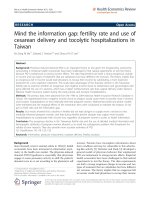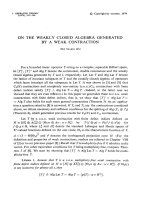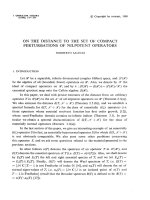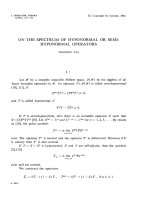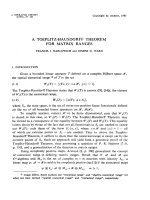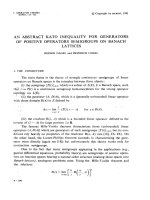Báo cáo toán học: "WHERE THE TYPICAL SET PARTITIONS MEET AND JOIN" pdf
Bạn đang xem bản rút gọn của tài liệu. Xem và tải ngay bản đầy đủ của tài liệu tại đây (192.76 KB, 15 trang )
WHERE THE TYPICAL SET PARTITIONS MEET AND JOIN.
Boris Pittel
Received: May 16, 1999; Accepted: January 15, 2000
The lattice of the set partitions of [n] ordered by refinement is studied.
Suppose r partitions p
1
, ,p
r
are chosen independently and uniformly at random. The
probability that the coarsest refinement of all p
i
’s is the finest partition {1}, ,{n}
is shown to approach 0 for r =2,and1 forr ≥ 3. The probability that the finest
coarsening of all p
i
’s is the one-block partition is shown to approach 1 for every r ≥ 2.
Introduction. Let Π
n
be the set of all set partitions of [n] , ordered by refinement.
That is, for two partitions p and p
, p p
if each block of p
is a union of blocks
of p. It is well known, Stanley [6], that Π
n
is a lattice; it means that every pair
of partitions p, p
has the greatest lower bound inf{p, p
} (p inf p
or p meet p
)and
the least upper bound sup{p, p
} (p sup p
or p join p
). Namely, inf{p, p
} is the
partition whose blocks are the pairwise intersections of blocks of p and p
, and it is
the “coarsest” (simultaneous) refinement of p and p
.sup{p, p
} is a partition whose
every block is both a union of blocks of p and a union of blocks of p
,withnoproper
subset of the block having that property; so it is the finest “coarsening” of p and p
.
Assigning to each p the same probability, 1/|Π
n
|, we transform Π
n
into the probability
space with uniform measure. There is a sizeable literature on the properties of the
uniformly distributed partition, see Pittel [5] and the references therein. Closer to the
subject of this paper, Canfield and Harper [1] and Canfield [2] used the probabilistic
tools to find the surprisingly sharp bounds for the length of the largest antichain in
Π
n
. In [5] we proved that the total number of refinements of the random partition is
asymptotically lognormal.
In the present paper we study the properties of inf
1≤i≤r
p
i
,sup
1≤i≤r
p
i
, under the as-
sumption that the uniform partitions p
1
, ,p
r
are independent. (Formally, we study
1991 Mathematics Subject Classification. 05A18, 05A19, 05C30, 05C80, 06A07, 60C05, 60Fxx.
Key words and phrases. Set partitions lattice, meet, join operations, enumeration, random, limit-
ing probabilities
Research supported in part by the NSF grant # DMS-9803410, and also by the Microsoft Research.
Typeset by A
M
S-T
E
X
1
2
the distributions of two random (partition-valued) variables defined on the product
of r copies of the probability space Π
n
.) Specifically, we want to know how likely
it is that inf
i
p
i
is the minimum partition p
min
= {{1}, ,{n}}, and that sup
i
p
i
is the maximum partition p
max
= {[n]}. We also discuss (briefly) the behavior of
inf(sup)
i
p
f
i
where p
f
is a partition of [n] into the level sets for a uniformly random
mapping f :[n] → [n].
I stumbled upon these problems trying to answer a question which was posed by
Stephanie Rieser (Steve Milne’s doctoral student at the Ohio State University) during
the Herb Wilf’s Festschrift (University of Pennsylvania, Summer 1996). Stephanie
asked for a formula of the number of partitions p
which intersect minimally (“are
disjoint from”) a given partition. These are p
with the property inf{p, p
} = p
min
!
Few weeks later I sent Stephanie an answer that expressed the number in question as a
certain coefficient of the explicit (multivariate) generating function. I understood then
vaguely that this solution might be relevant for (asymptotic) enumeration of minimally
intersecting partitions, (pairs and tuples). However, I hadn’t got back to these issues
until earlier this year.
In Section 1 we enumerate the minimally intersecting partitions, with Corollary 1
containing the answer to Rieser’s question, and end up (Theorem 1, Theorem 2) with
a formula for the total number of r -tuples of such partitions. In Section 2 we use
the enumerational results to estimate the probability that r independent partitions
intersect minimally. It turns out (Theorem 3) that this probability is fast approaching
zero as n →∞if r = 2, and its limit is 1 for every other r>2. We look closer
at inf{p
1
,p
2
} and prove (Theorem 4) that this refinement of p
1
and p
2
is unlikely
to have blocks of size three or more, and that the number of two-element blocks is
asymptotically Poisson, with a parameter close to 0.5log
2
n. We conclude by proving
(Theorem 5) that sup
i
p
i
= p
max
with probability tending to 1, for every r ≥ 2.
1. Enumeration of minimally intersecting partitions.
Lemma 1. Let a partition p of [n] be given, and let i
1
, i
k
denote the sizes of
blocks in p listed in any order. For a given >1, define N(p, ) as the total number
of partitions p
with blocks exactly that intersect p minimally. Then
(1.1) N(p, )=
i!
!
· [x
i
]
k
α=1
(1 + x
α
) − 1
.
Here i!=
k
α=1
i
α
!, and the second factor is the coefficient of
k
α=1
x
i
α
α
in the power
expansion for the indicated function.
3
Corollary 1. N(p), the overall number of the partitions p
that intersect p mini-
mally, is given by
(1.2) N(p)=i![x
i
]exp
k
α=1
(1 + x
α
) − 1
.
Note. As a partial check, for p = ∪
i
{i}, N(p) is the Bell number B(n). And
indeed
[x
1
···x
n
]exp
n
α=1
(1 + x
α
) − 1
=e
−1
[x
1
···x
n
]
∞
j=0
1
j!
n
α=1
(1 + x
α
)
j
=e
−1
[x
1
···x
n
]
∞
j=0
1
j!
n
α=1
(1 + jx
α
)
=e
−1
∞
j=0
j
n
j!
,
which is the Dobinski formula for B(n), Comtet [1].
ProofofLemma1.Given ≥ 1, j
1
, j
≥ 1, such that
(1.3)
β=1
j
β
= n,
denote by N(p, j) the total number of partitions p
with blocks of sizes j
1
, ,j
which intersect p minimally. Every p
is characterized, albeit incompletely, by the
matrix [ε
αβ
], 1 ≤ α ≤ k,1≤ β ≤ .Hereε
αβ
∈{0, 1} is the cardinality of
intersection of the α-th block in p and the β -th block in p
, cardinality of the latter
being j
β
.Thatis
α
ε
αβ
= j
β
, 1 ≤ β ≤ ,
β
ε
αβ
= i
α
, 1 ≤ α ≤ k,
and the total number of solutions of this system is
(1.4) [x
i
y
j
]
α,β
(1 + x
α
y
β
).
Now, there are i
α
! ways to decide how to assign the elements from the α-th block of p
to those i
α
nonzero ε
αβ
’s, and the overall number of partitions p
appears to be the
4
expression (1.4) times i!. However each such p
has been counted more than once. If
m
j
is the multiplicity of j in the multiset {j
1
, ,j
}, then the compensating factor
is
!
m
1
! ···m
n
!
−1
·
m
1
! ···m
n
!
−1
=
1
!
.
Hence
(1.5) N(p, j)=
i!
!
· [x
i
y
j
]
1≤α≤k
1≤β≤
(1 + x
α
y
β
).
Our j satisfies (1.3). It is easy to see that the second factor on the right in (1.5) is
zero if j does not meet (1.3). Consequently N (p, ), the total number of partitions p
with blocks that intersect p minimally is given by
N(p, )=
j
1
+···+j
=n
j
1
, ,j
>0
N(p, j)
=
i!
!
· [x
i
]
j
1
, ,j
>0
[y
j
]
α,β
(1 + x
α
y
β
)
.(1.6)
It is crucially important that we are able to drop the condition
β
j
β
= n in the last
sum. Using inclusion-exclusion principle, we substitute
A⊆[]
(−1)
|A|
S(A, x),
for the sum. Here
S(A, x)=
j
1
, ,j
≥0
j
β
=0 if β∈A
[y
j
]
α,β
(1 + x
α
y
β
)
=
j
β
≥0,β∈A
c
β∈A
c
y
j
β
β
α≤k, β∈A
c
(1 + x
α
y
β
)
=
α≤k
(1 + x
α
)
|A
c
|
.
Therefore the sum in (1.6) equals
A⊆[]
(−1)
|A|
α≤k
(1 + x
α
)
−|A|
=
m≤
(−1)
m
m
α≤k
(1 + x
α
)
−m
=
α≤k
(1 + x
α
) − 1
.
5
Thus (1.1) is proved.
The corollary follows by summing over >0 and noting that the expression on the
right in (1.1) is zero for =0.
Lemma 2. Let N
2
(k) denote the number of ordered pairs (p, p
) of minimally inter-
secting partitions such that p consists of k blocks exactly. Then
(1.7) N
2
(k)=e
−1
n!
k!
· [x
n
]
≥0
1
!
(1 + x)
− 1
k
.
Proof of Lemma 2. By Corollary 1,
N
2
(k)=
1
k!
i
1
+···+i
k
=n
i
1
, ,i
k
>0
n!
i!
i! · [x
i
]exp
k
α=1
(1 + x
α
) − 1
=e
−1
n!
k!
i
1
+···+i
k
=n
i
1
, ,i
k
>0
[x
i
]exp
k
α=1
(1 + x
α
)
.
Predictably, we want to use the inclusion-exclusion principle again. In preparation,
for a given A ⊆ [k],
S(x, A):=
i
1
+···+i
k
=n
i
1
, ,i
k
≥0
i
α
=0 if a∈A
α∈A
c
x
i
α
α
exp
k
α=1
(1 + x
α
)
=[x
n
]exp
(1 + x)
|A
c
|
=[x
n
]
∞
=0
1
!
(1 + x)
|A
c
|
.
Therefore
N
2
(k)=e
−1
n!
k!
[x
n
]
A⊆[k]
(−1)
|A|
S(x, A)
=e
−1
n!
k!
· [x
n
]
∞
=0
1
!
(1 + x)
|A
c
|
=e
−1
n!
k!
· [x
n
]
∞
=0
1
!
k
m=0
(−1)
m
k
m
(1 + x)
(k−m)
=e
−1
n!
k!
· [x
n
]
∞
=0
1
!
(1 + x)
− 1
k
.
6
Theorem 1. N
2n
, the overall number of ordered pairs (p, p
) of minimally intersect-
ing partitions, is given by
(1.8) N
2n
= e
−2
k,≥0
(k)
n
k!!
,
where (m)
n
= m(m − 1) ···(m − n +1).
Proof of Theorem 1. By Lemma 2,
N
2n
=
k>0
N
2
(k)
=e
−1
n!
≥0
1
!
· [x
n
]
k≥0
1
k!
(1 + x)
− 1
k
=e
−1
n!
≥0
1
!
· [x
n
]exp
(1 + x)
− 1
=e
−2
n!
≥0
1
!
k≥0
1
k!
k
n
=e
−2
k,≥0
(k)
n
k!!
.
Note. We used k, both as the numbers of blocks for a generic pair (p, p
)andas
the summation indices in (1.8), and in (1.7). Needless to say, (1.8) should not be read
as implying that the total number of minimally intersecting pairs (p, p
)withk and
blocks respectively is e
−2
(k)
n
/(k!!). For one thing, the expression is irrational!
However, the magnitude of that number is strongly correlated to the (k, )-th term,
at least for the dominant values of k and .
In the light of this Theorem, the following statement must be true, and it is!
Theorem 2. Given r ≥ 2,letN
rn
denote the total number of ordered r -tuples of
partitions (p
1
, ,p
r
) with a property that inf
i
p
i
= p
min
.Then
(1.9) N
rn
= e
−r
k
1
, k
r
≥0
(k
1
···k
r
)
n
k
1
! ···k
r
!
.
Proof of Theorem 2. Let the numbers k
1
, ,k
r
> 0 be given. For every s ≤ r,
let i
s
=(i
s1
, ,i
sk
s
)beak
s
-tuple of positive integers that add up to n. Fix a parti-
tion p
1
with k
1
blocks of given cardinalities, listed in i
1
. Introduce N(p
1
, i
2
, ,i
r
),
the total number of (r − 1)-tuples (p
2
, ,p
r−1
) of partitions, such that p
s
has k
s
7
blocks of cardinalities i
s
,(2≤ s ≤ r), with the property inf
1≤i≤r
p
i
= p
min
.Let
N(p
1
,k
2
,k
r
) be the analogous number when only the number of blocks in each
p
s
, (2 ≤ s ≤ r), is given. Analogously to (1.5), we obtain
(1.10) N(p
1
, i
2
, ,i
r
)=
i
1
!
r
s=2
k
r
!
·
x
i
1
y
i
2
···z
i
r
1≤β
s
≤k
s
1≤s≤r
(1 + x
β
1
y
β
2
···z
β
r
) .
Adding up N(p
1
, i
2
, ,i
r
) for given k
2
, ,k
r
, and acting like in (1.8), we have:
(1.11)
N(p
1
,k
2
, ,k
r
)=i
1
! · [x
i
1
]
1≤β
s
≤k
s
2≤s≤r
u
r
s=2
(k
s
−β
s
)
r
t=2
(−1)
β
t
k
t
!
k
t
β
t
;
u :=
1≤α≤k
1
(1 + x
α
).
Then we use
N
rn
=
k
1
1
k
1
!
i
11
+···+i
1b
1
=n
i
11
, i
k
1
1
>0
n!
i
1
!
k
2
, ,k
r
N(p
1
,k
2
, ,k
r
),
and, applying the inclusion-exclusion to the condition i
1
> 0, we arrive at
N
rn
=n! · [x
n
]
k
1
, ,k
r
≥0
r
s=1
1
k
s
!
β
1
≤k
1
, ,β
r
≤k
r
u
r
s=1
(k
s
−β
s
)
r
t=1
(−1)
β
t
k
t
!
k
t
β
t
;
u :=1 + x.
An easy induction on r (based on the devices used above for r = 2) shows that the
last sum equals
e
−r
k
1
, ,k
r
≥0
u
k
1
···k
r
k
1
! ···k
r
!
,
and it remains to notice that
[x
n
](1 + x)
k
1
···k
r
=
k
1
···k
r
n
.
Note. Herb Wilf (private communication) indicated that (1.9) is equivalent to
(1.12) N
rn
=
n
j=1
B
r
(j)S(n, j);
8
here the S(n, j)aresigned Stirling numbers of the first kind. Does the reader see
why?
2. Probabilistic asymptotics. Suppose that the partitions p
1
, ,p
r
are chosen
from Π
n
uniformly at random (uar), independently of each other. The formulas (1.8),
(1.9) are ideally suited for an asymptotic study of
P
rn
def
=Pr
inf
1≤i≤r
p
i
= p
min
.
According to Theorems 1 and 2,
P
rn
=
N
rn
B
r
(n)
,
where B(n) is the Bell’s n-th number, that is B(n)=
Π
n
. By the Moser-Wyman
formula [4],
(2.1) B(n)=
1+o(1)
ρ
1/2
· exp
n(ρ − 1+1/ρ) − 1
,n→∞,
where ρ is defined as the root of ρe
ρ
= n, and asymptotically
(2.2) ρ =logn − (1 + o(1)) log log n.
Note. It can be shown that actually o(1) = O(1/ρ) in this formula, [5].
Theorem 3.
(2.3) P
rn
=
(1 + o(1))e
−ρ
2
/2
, if r =2,
1 − O(log
−1
n), if r ≥ 3.
So lim
n→∞
P
rn
is 0 for r =2 and 1 for every r>2.
Proof of Theorem 3. The computations are more or less standard, with “less” due
to the sum in (1.9) being multiple. So we will outline the argument, paying attention
to the key points.
A typical partition has about n/ log n blocks. This is why we should expect that the
dominant contribution to the series in (1.9) comes from the summands with k
1
, ,k
r
all asymptotic to n/ log n. Indeed N
rn
(k), the generic summand in (1.9), can be
transformed—via the Stirling formula for factorials—into
(2.4)
N
rn
(k)=
1+O(
r
s=1
1/k
s
+1/(k − n))
N
rn
(k);
N
rn
(k):=e
−r
r
s=1
(2πk
s
)
−1/2
· exp(H(k));
H(k):=− n +
r
s=1
(k
s
− k
s
log k
s
)+k log k − (k − n) log(k − n);
k :=
r
s=1
k
s
.
9
The estimate is uniform for all k > 0 such that k>n.Thetermsforthevaluesofk
left out are either zero, when some k
s
= 0, or negligible, if k = n. H(k) attains its
absolute maximum at a point k =(k, ,k), where k is the root of
(2.5) κ
r−1
log
κ
r
κ
r
− n
− log κ =0.
Therefore n/k ∼ log k,sothatk ∼ n/ log n. More accurately, we set k = n/x,so
that x ∼ log n, and obtain from (2.5):
x − log
n
x
= −
x
r+1
2n
r−1
+ O
log
2r+1
n
n
2r−2
.
Comparing the last equation with
ρ − log
n
ρ
=0,
we see that
(2.6) x = ρ −
ρ
r+1
2n
r−1
+ O
log
2r+1
n
n
2r−2
.
Combination of (2.4)-(2.6) yields
H(k)=rn
x
−1
− x
−1
log
n
x
+log
n
x
−
n
2
2k
r
+ O
n
3
k
2r
=nr(ρ
−1
− 1+ρ) −
ρ
r
2n
r−2
+ O
log
2r
n
n
2r−3
.
(For the last line we have used the fact that the displayed function of x has zero
derivative at x = ρ.) We notice immediately that the term −ρ
r
/(2n
r−2
)iseither
−ρ
2
/2 →−∞,ifr =2,orisO(log
r
n/n), if r>2. Furthermore, for k − k≤
n
1/2
log n,
(2.7)
∂
2
H(k)
∂s
1
∂s
2
=
−
ρ
2
+ ρ
n
+ O
log
4
n
n
3/2
, if s
1
= s
2
,
O
log
r+2
n
n
r
, if s
1
= s
2
.
Introducing
x
s
=
k
s
− k
s
n
1/2
(ρ
2
+ ρ)
1/2
, ∆x
s
=
ρ
2
+ ρ
n
1/2
, 1 ≤ s ≤ r,
10
and using (2.4), (2.7), we get then: within a factor 1 + O(n
−1/2
log
4
n),
k−k≤n
1/2
N
rn
(k)=
2π(ρ +1)
−r/2
exp
nr(ρ − 1+1/ρ) − r −
ρ
r
2n
r−2
·
x−x≤(ρ
2
+ρ)
1/2
exp
−
1
2
r
s=1
x
2
s
r
s=1
∆x
s
.
Next, within a factor 1+O(∆x
1
), the last sum equals the corresponding r -dimensional
integral, and the latter is within the distance of order
|x|>ρ/r
e
−x
2
/2
dx = o
e
−ρ
2
/(2r
2
)
from the integral over R
r
.Thus
(2.8)
k−k≤n
1/2
N
rn
(k)=
1+O(n
−1/2
log
4
n)
exp
nr(ρ − 1+ρ
−1
) − r −
ρ
r
2n
r−2
(ρ +1)
r/2
.
In addition, using (k
1
···k
r
)
n
≤ k
n
1
···k
n
r
and the Dobinski formula for B(n),
(2.9)
k−k>n
1/2
N
rn
(k) ≤ rB
r−1
(n) · e
−1
|k−k|>r
−1
n
1/2
log n
k
n
k!
.
The fraction k
n
/k! attains its absolute maximum at some k
∗
so close to n/ρ, whence
to k , that the condition on k implies |k − k
∗
| > (2r)
−1
n
1/2
log n. The function k
n
/k!
is roughly exp(H(k)), where H(k)=n log k − k log(k/e)isconvex. H(k) has its
maximum at k = n/ρ,and
H
nρ
−1
+ θn
1/2
log n
≤−
ρ
2
2n
, ∀θ ∈ [−1, 1].)
Therefore
exp
H
nρ
−1
± (2r)
−1
n
1/2
log n
≤ exp
−c
∗
log
4
n
,
and with a bit of extra effort it follows that
e
−1
|k−k|>(2r)
−1
n
1/2
log n
k
n
k!
≤ B(n)exp
−c
log
4
n
,
11
with c
<c
∗
. Hence (2.9) reduces to
(2.10)
k−k>n
1/2
log n
N
rn
(k)=O
B
r
(n)e
−c
log
4
n
.
Using (2.8), (2.10) and (2.1) (see also the note following (2.2)), we conclude that
P
rn
=
1+O(ρ
−1
)
exp
−
ρ
r
2n
r−2
+ O
e
−c
log
4
n
.
Since p
:= inf{p
1
,p
2
} is so unlikely to be the finest partition, an interesting question
is what is the size of the largest block of p
typically? The answer is: two. And how
many two-elements sets are there in p
? The answer is: only about log
2
n/2.
Theorem 4. Introduce Q
n
(k), the probability that p
= p
min
, that the largest block
has size two, and that there are k such blocks. If k = o(n
1/2
),then
(2.11) Q
n
(k)=(1+o(1))e
−λ
λ
k
k!
,λ:=
ρ
2
2
.
Thus the number of two-element sets in p
is Poisson distributed with a large parameter
ρ
2
/2, and with probability approaching one p
has no larger blocks.
ProofofTheorem4. The total number of (p
1
,p
2
) such that p
has k two-element
blocks, and no larger blocks, is
n
2k
(2k − 1)!! · N
2,n−k
.
(We choose 2k elements in
n
2k
ways, then pair them in
(2k − 1)!!=1· 3 ···(2k − 1) =
(2k)!
2
k
k!
ways, and finally select an ordered pair of minimally intersecting partitions on the
resulting set of n − 2k + k elements, k of them being the pairs, and n − 2k of them
being the singletons left out.) Then
(2.12)
Q
n
(k)=
n
2k
(2k)!B
2
(n − k)P
2,n−k
2
k
k!B
2
(n)
=
1+O(k
2
/n)
n
2k
2
k
k!
·
B(n − k)
B(n)
2
· P
2,n−k
.
12
By Theorem 3,
P
2,n−k
=
1+O(ρ
−1
(n − k))
exp
−ρ
2
(n − k)/2
,
where ρ(x) satisfies
(2.13) ρ(x)e
ρ(x)
= x ⇐⇒ ρ(x)+logρ(x)=logx.
It follows from the last equation that
(2.14) ρ(n − k)=ρ + O(k/n).
Furthermore, by (2.1),
B(n − k)
B(n)
=(1 + o(1)) exp
f(n − k) − f(n)
;
f(x):=x(ρ(x) − 1+ρ(x)),(2.15)
and it is easy to see, via (2.13), that f
(x)=r(x). Invoking (2.14) also, we compute
(2.16) f(n − k) − f(n)=−k
ρ + O(k/n)
= −kρ + O(k
2
/n).
Putting together (2.12)-(2.16) leads to
Q
n
(k)=
1+O(k
2
/n)
n
2k
2
k
k!
· e
−2kρ
· e
−ρ
2
/2
=
1+O(k
2
/n)
(ρ
2
/2)
k
k!
· e
−ρ
2
/2
.
Note. For a given mapping f :[n] → [n], the sets {i ∈ [n]:f(i)=j} form a
partition p
f
of [n]. If f is chosen uar from the set of all n
n
mappings then p
f
is
random, but not uniform. We suggest the interested reader show that for f
1
,f
2
chosen
independently
lim
n→∞
Pr
inf{p
f
1
,p
f
2
} = p
min
= e
−1/2
.
(Hint: the reader may wish first to show that it is unlikely for inf{p
f
1
,p
f
2
} to have a
block of size three or more, and second to evaluate the factorial moments of the number
of two-element blocks.) This result shows that two models of random set partitions
differ substantially.
It remains to estimate the probability that sup
1≤i≤r
p
i
is the one-block partition p
max
,
the coarsest one. Exact enumeration of such r -tuples appears to be very hard. We
can prove, however, that for n large, almost all r tuples have that property.
13
Theorem 5. Denote P
rn
= Pr
sup
1≤i≤r
p
i
= p
max
.Then
(2.17) P
rn
=1− O
log
r+1
n
n
r−1
.
Proof of Theorem 5. Given the event sup
i
p
i
= p
max
, there exists a nonempty
proper subset A of [n] such that each p
i
is obtained by partitioning separately A and
[n] \ A. Therefore
(2.18) 1 −P
rn
≤ 2
m≤n/2
n
m
B(m)B(n − m)
B(n)
r
.
Using the computations analogous to (2.13)–(2.16), it is easy to prove that R(m), the
ratio of the two consecutive terms, (m + 1)-th and m-th, approaches zero uniformly
for m ≤ n
1/2
,say.(Thechoiceofn
1/2
is somewhat arbitrary.) For m ∈ [n
1/2
,n/2],
(2.19)
R(m)=
1+O(log
−1
n)
n − m
m
e
rρ(m)
e
rρ(n−m)
=
1+O(log
−1
n)
exp
g(m) − g(n − m)
;
g(x):=(r − 1)ρ(x) − log ρ(x).
Now
g
(x)=
(r − 1) −
1
ρ
·
dρ
dx
=
(r − 1) −
1
ρ
ρ
x(1 + ρ)
.
So, for x ∈ [n
1/2
,n/2], there exists a positive c such that g
(x) ≥ c/x. Then, by
(2.19),
R(m) ≤
1+O(log
−1
n)
exp
−c
n−m
m
x
−1
dx
=
1+O(log
−1
n)
m
n − m
c
.
Therefore, given a>0, there exists b>0 so large that
R(m) ≤ 1 − a/ log n, ∀ m ∈
n
1/2
, (n/2)(1 − b/ log n)
,
for all n>n(a). Consequently, the corresponding terms in the sum on the right of
(2.18) are dominated by those of a geometric series with denominator 1−a/ log n,and
their overall contribution is bounded by
(2.20)
n
B(n − 1)
B(n)
r
·
1
1 − (1 − a/ log n)
=O
n log n exp
−rρ(n)
=O
log
r+1
n
n
r−1
.
14
(For the first line we have used (2.15) and (2.16).)
For m ∈
(n/2)(1 − b/ log n),n/2], we use (2.15) again and bound
(2.21)
n
m
B(m)B(n − m)
B(n)
r
≤ 2
n+1
exp
rf(m)+rf(n − m) − rf(n)
.
Since
f
(x)=ρ(x),ρ
(x)=
ρ(x)
x(1 + ρ(x))
,
we write for m in question:
f(m)=f (n/2) −
n/2
m
ρ(x) dx
=f(n/2) − (n/2 − m)ρ(n/2) + O
n
−1
(n/2 − m)
2
.
Analogously,
f(n − m)=f(n/2) + (n/2 − m)ρ(n/2) + O
n
−1
(n/2 − m)
2
.
So
f(m)+f (n − m) − f (n)=2f (n/2) − f(n)+O
n log
−2
n
=n
ρ(n/2) − ρ(n)
+ O
n log
−1
n
= − n
n
n/2
ρ(x)
x(1 + ρ(x))
dx + O
n log
−1
n
= − n log 2 + O
n log
−1
n
.
Therefore the right-hand side of (2.21) becomes 2
−n(r−1)(1+o(1))
, and multiplying this
bound by (n/2)b/ log n,thenumberofm’s in question, we get the same 2
−n(r−1)(1+o(1))
,
with a slightly larger term o(1). Thus, by (2.20),
1 −P
rn
= O
log
r+1
n
n
r−1
.
Note. For the random set partitions p
f
, however,
lim
n→∞
Pr
sup
1≤i≤r
p
f
i
= p
max
=0,
for every r ≥ 1. (Does the reader see a simple proof of this?) It is tempting to
“explain” such a difference from the case of uniform partitions by the fact that a typical
15
such partition has about n/ log n blocks, while the one induced by the uniformly
random mapping has more blocks, about
1 − e
−1
n. (The number of “no-values”
of the uniformly random mapping is close, in probability, to e
−1
n.) However, the
difference between n and n/ log n does not seem to be sufficiently large to account for
such a sharp contrast with the uniform partitions.
Acknowledgement. I am indebted to Steve Milne and Steph Rieser for their interest
in this study, and to George Andrews, Ira Gessel and Herb Wilf for expert comments.
I was delighted to read Herb’s response that contained (1.12), an elegant transform
of (1.9). I am very grateful to Christian Borgs, Jennifer Chayes and Jeong Han Kim
who supported my request to visit Microsoft in April-June of 1999.
References
1. E. R. Canfield and L.H. Harper, Large antichains in the partition lattice, Random Structures and
Algorithms 6 (1995), 89–104.
2. E. R. Canfield, The size of the largest antichain in the partition lattice,J.Comb.Theory,A83
(1998), 188-201.
3. L. Comtet, Advanced Combinatorics, D. Reidel, Dordrecht-Holland / Boston-U.S.A., 1974.
4. L. Moser and M. Wyman, An asymptotic for the Bell numbers,Trans.Roy.Soc.Can.49 (1955),
49–54.
5. B. Pittel, Random set partitions: asymptotics of subset counts,J.Comb.Theory,A79 (1997),
326–359.
6. R. S. Stanley, Enumerative Combinatorics, Wadsworth & Brooks/Cole, Monterey, California,
1986.
